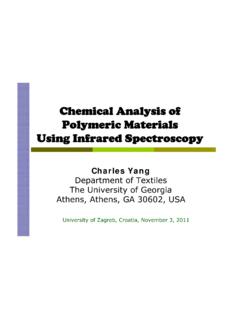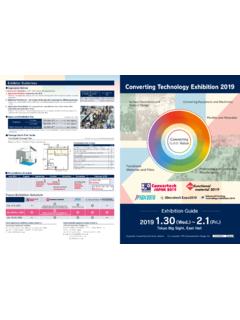Transcription of Distribution (SPD) curves were plotted as graphs Sunlight ...
1 Sunlight , UV, & Accelerated Weathering By Patrick Brennan & C. Fedor1 The Q-Panel Company 26200 First Street, Cleveland, Ohio 441 45 INTRODUCTION Sunlight is an important cause of damage to plastics, textiles, paints, and other organic materials. Short wavelength ultraviolet light has long been recognized as being responsible for most of this damage2. Spectroradiometric measurements were made to quantify the wide variations in UV content of Sunlight under the following conditions: direct summer Sunlight , winter Sunlight , Sunlight filtered through ordinary window glass and Sunlight filtered through automotive glass.
2 Accelerated weathering testers are widely used for research and development, quality control, and material certification. They employ a variety of light sources to simulate Sunlight and the damage caused by Sunlight . Comparative spectroradiometric measurements of various types of accelerated testers also showed a wide variety of UV spectra. These measurements help highlight the advantages and disadvantages of the various accelerated light sources: enclosed carbon arc, sunshine carbon arc, xenon arc and fluorescent UV. The measurements suggest recommendations for the use of different light sources for different applications.
3 Two new types of fluorescent UV lamps show promise for improved correlation with natural exposures. EXPERIMENTAL A spectroradiometer was used to measure the spectral irradiance received by test samples exposed to Sunlight or accelerated testers. "Irradiance" is the rate at which light energy falls on a unit area of surface. "Spectral irradiance" is the Distribution of irradiance with respect to wavelength. In this case the irradiance was measured at each 1 nanometer (nm) wavelength band throughout the wavelength region of interest. The Resulting Spectral Power 1.
4 Presented at the Society of Plastics Engineers Automotive RETEC. Nov. 1987. 2. Searle. N. and His. R. "UV SPD of Sunlight ,'J. Optical Soc. America, Vol. 55. NI Distribution (SPD) curves were plotted as graphs of irradiance versus wavelength. Measurements of Sunlight were taken at solar noon with the sensor kept at normal incidence to the sun with a solar tracking equatorial drive system. The sensor viewed the whole sky, so that complete global Sunlight was measured. Measurements of the accelerated light sources were taken with the sensor in the same position as an ordinary test sample, so that the irradiance measured would be the same as a sample receives.
5 All measurements were taken with the same instrument to ensure that the various SPD curves would be strictly comparable. Attempting to com- pare SPD curves generated by different spectro- radiometers is a frequent source of error in this field, due to different types of input optics, different wave- length bandpasses, or simply due to limitations in the state of the art in spectral irradiance calibrations of diffuse UV sources like the sky or fluorescent lights. The instrument used was an International Light IL 700 Spectroradiometer, No. 504, consisting of the following components as shown below: Input Optics: IL-2WE Double Wide Eye, quartz double lens cosine diffuser for wide viewing angle Monochromatec Kratos GM-200, double grating monochromator with calibrated nanometer band pass, stray light less than 1 part per million.
6 Detectoc PM 270C Photo-multiplier, with an S-5 response, operated from an IL 760 power supply. Picoammetec IL 700A Radiometer. Calibration: Microwatts per square centimeter per nanometer, traceable to the National Bureau of Stan- dards. Calibration Certificate: 404045901. I Photomultiplier pic~ammeter I Spectroradiometer Cosine Schematic Diffuser Sunlight The electromagnetic energy from Sunlight is normally divided into ultraviolet light, visible light, and infrared energy. Figure 2 shows the spectral power Distribution (SPD) of noon midsummer Sunlight , measured in Cleveland Ohio, June, 1986.
7 infrared energy (not shown) consists of wavelengths longer than the visible red wavelengths and starts above about 760 nanometers (nm). Visible light is defined as radiation between 400 and 760 nm. Ultraviolet light consists of radiation below 400 nm. The International Commission on Illumination (CIE) further subdivides the UV portion of the spec- trum into UV-A, UV-B and UV-C as shown below3. Wavelength (nanometers) Figure 2 -The Sunlight Spectrum The effects of the various UV wavelength regions can be summarized as shown in the following table4.
8 WAVELENGTH REGIONS OF THE UV VARIABILITY OF Sunlight UV-A 400 to 315 nm UV-B 315 to 280 nm uv-C 280 to loo nm Because UV is easily filtered by air mass, cloud cover, pollution, etc., the amount and spectrum of natural UV exposure is extremely variable. Figure 3 shows a comparison of the UV regions of Sunlight , measured at Cleveland at noon on: Causes polymer damage Includes the shortest wavelengths found at the earth's surface; responsible for severe polymer damage; absorbed by window glass. Found only in outer space; filtered out by earth's atmosphere; germicidal The summer solstice (longest day of the year), The winter solstice (shortest day of the year), The spring equinox.
9 3. ClE Standard No. 20. 4. Grossman, D. " Know Your Enemy: The Weather." J. Vinyl Vol. 3. No. 1. 5. Zerlaut, G. "Accelerated Weathering & UV Measurements", ASTM STP 781, pp These measurements are in essential agreement with data reported by other investigators5. Because the sun is lower in the sky during the winter months, it is filtered through a greater air mass. This creates two important differences between summer and winter Sunlight : changes in the intensity of the light and in the spectrum. Most important, the shorter, more damaging UV wavelengths are filtered out during winter.
10 For example, the intensity of UV at 320 nm changes about 8 to 1 from summer to winter. This is especially significant for polymeric materials such as PVC. In addition, the short wavelength solar cut-off shifts from about 295 nm in summer to about 310 nm in winter. Consequently, materials sensitive to UV below 310 nm would degrade only slightly, if at all, during the winter months. The Sunlight spectrum at the March 21 equinox falls between the June and December curves . 260 280 300 320 340 360 380 400 Wavelength (nanometers) Figure 3 - Seasonal Variation of Sunlight UV ACCELERATED LIGHT SOURCES COMPARED TO Sunlight The following discussion of light sources will con- fine itself to the question of UV spectrum.





